Illustration Credit: Noa Kelner

The מִשְׁכָּן (Mishkan) was the sanctuary for God that Benei Yisrael built in the wilderness. It was the place where God spoke to Moshe, and where Benei Yisrael served God through rituals such as offering קָרְבָּנוֹת (korbanot, sacrifices) and burning the spices of the קְטֹרֶת (ketoret, incense).
For the next several weeks, the weekly parashah will be about the construction of the Mishkan. God gives very detailed instructions for how to do this! Devash this week features a close look at each of the Mishkan’s larger כֵּלִים (keilim, vessels).
The Torah measures these keilim using אַמּוֹת (amot) and טְפָחִים (tefahim).
What’s an אַמָּה (amah)?
An amah is often called a “cubit” in English. The word amah also means “arm,” and the measurement is about the length of an adult’s forearm (elbow to fingers). There are different opinions about exactly how long this is. It’s generally understood to be around 18-24 inches.
What’s a טֶפַח (tefah)?
A tefah is the width of a hand. There are six tefahim in an amah. So, if one amah is about 18 inches, one tefah would be about three inches.
Aron
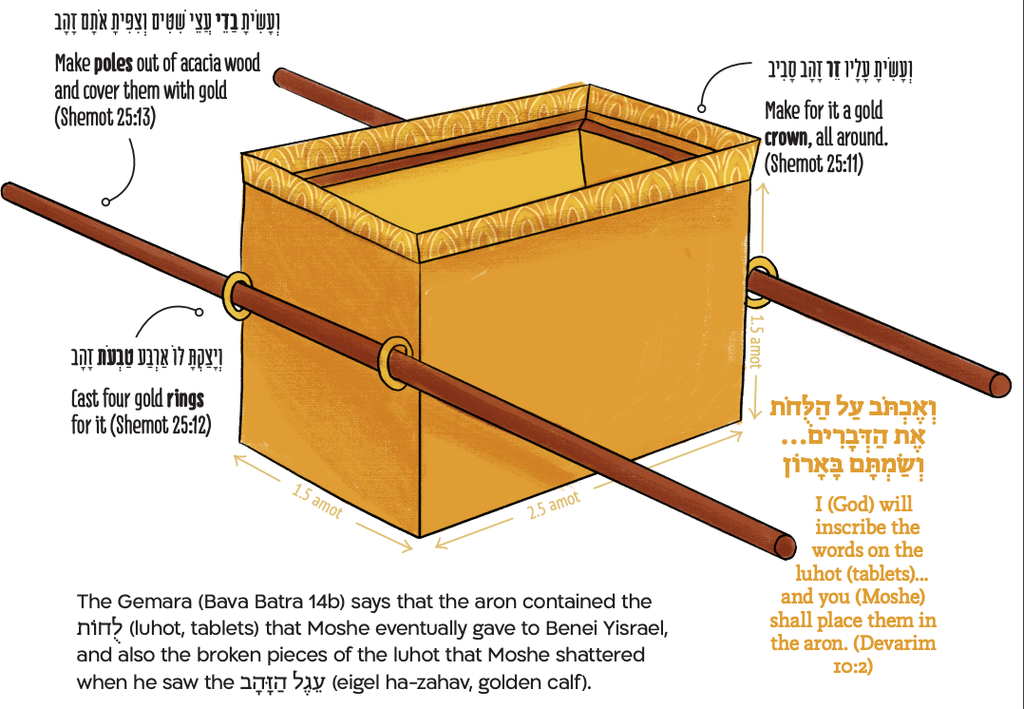
וְעָשׂוּ אֲרוֹן עֲצֵי שִׁטִּים… וְצִפִּיתָ אֹתוֹ זָהָב טָהוֹר מִבַּיִת וּמִחוּץ תְּצַפֶּנּוּ
Make an aron (ark) out of acacia word…cover it with pure gold from inside and from outside
וְיָצַקְתָּ לּוֹ אַרְבַּע טַבְּעֹת זָהָב
Cast four gold rings for it
(יג) וְעָשִׂ֥יתָ בַדֵּ֖י עֲצֵ֣י שִׁטִּ֑ים וְצִפִּיתָ֥ אֹתָ֖ם זָהָֽב׃
(13) Make poles of acacia wood and overlay them with gold;
וְעָשִׂיתָ עָלָיו זֵר זָהָב סָבִיב
Make for it a gold crown, all around.
וְאֶכְתֹּב עַל הַלֻּחֹת אֶת הַדְּבָרִים… וְשַׂמְתָּם בָּאָרוֹן
I (God) will inscribe the words on the luhot (tablets)... and you (Moshe) shall place them in the aron.
The Gemara (Bava Batra 14b) says that the aron contained the לֻחוֹת (luhot, tablets) that Moshe gave to Benei Yisrael, and also the broken pieces of the luhot that Moshe shattered when he saw the עֵגֶל הַזָּהָב (eigel ha-zahav, golden calf).
R. Yehoshua ben Levi teaches a lesson based on this idea:
וְהִזָּהֲרוּ בְּזָקֵן שֶׁשָּׁכַח תַּלְמוּדוֹ מֵחֲמַת אוֹנְסוֹ. דְּאָמְרִינַן: לוּחוֹת וְשִׁבְרֵי לוּחוֹת מוּנָּחוֹת בָּאָרוֹן.
Be careful to give honor to elderly scholars who have forgotten their Torah learning (because of old age). Because we say: The second luhot and the broken pieces of the first luhot were both placed in the aron.
- What do the broken pieces of the first luhot represent in this teaching? What can we learn from how they were treated?
- Why is it important to give honor to something or someone that once contained Torah, even if they don’t anymore?
Kaporet כַפֹּרֶת
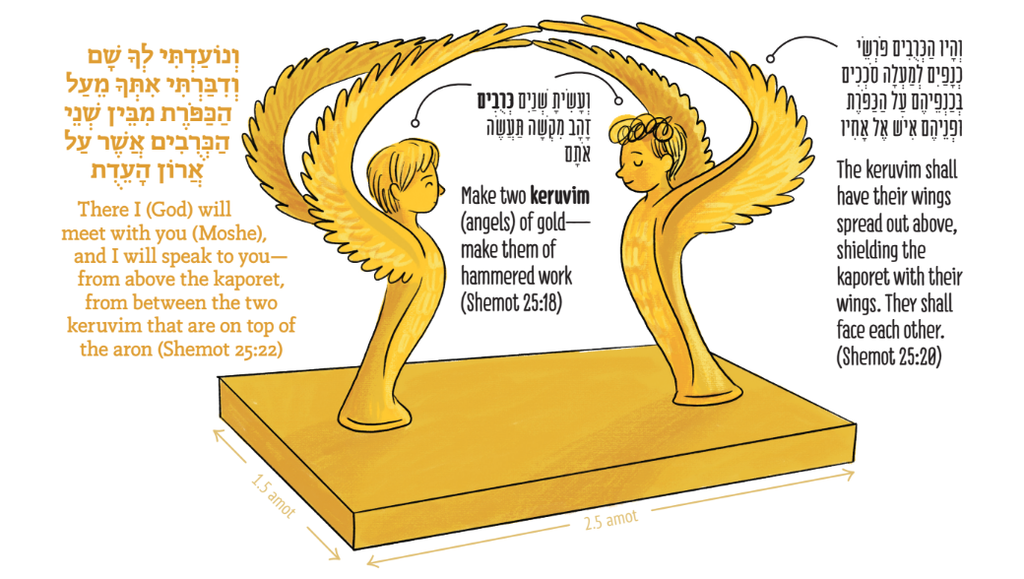
וְעָשִׂיתָ כַפֹּרֶת זָהָב טָהוֹר
Make a kaporet from pure gold
וְעָשִׂיתָ שְׁנַיִם כְּרֻבִים זָהָב מִקְשָׁה תַּעֲשֶׂה אֹתָם
Make two keruvim (angels) of gold—make them of hammered work
וְהָיוּ הַכְּרֻבִים פֹּרְשֵׂי כְנָפַיִם לְמַעְלָה סֹכְכִים בְּכַנְפֵיהֶם עַל הַכַּפֹּרֶת וּפְנֵיהֶם אִישׁ אֶל אָחִיו
The keruvim shall have their wings spread out above, shielding the kaporet with their wings. They shall face each other.
וְנוֹעַדְתִּי לְךָ שָׁם וְדִבַּרְתִּי אִתְּךָ מֵעַל הַכַּפֹּרֶת מִבֵּין שְׁנֵי הַכְּרֻבִים אֲשֶׁר עַל אֲרוֹן הָעֵדֻת
There I (God) will meet with you (Moshe), and I will speak to you—from above the kaporet, from between the two keruvim that are on top of the aron
Our Rabbis notice a contradiction. Our parashah says that the keruvim faced each other (like they’re illustrated here). But in another place in Tanakh, the keruvim are described as: וּפְנֵיהֶם לַבַּיִת (their faces are toward the sanctuary) (Divrei Ha-Yamim Bet 3:13). That would mean they’re facing off to the side, not toward each other. So, which way did they actually face?
לָא קַשְׁיָא; כָּאן בִּזְמַן שֶׁיִּשְׂרָאֵל עוֹשִׂין רְצוֹנוֹ שֶׁל מָקוֹם, כָּאן בִּזְמַן שֶׁאֵין יִשְׂרָאֵל עוֹשִׂין רְצוֹנוֹ שֶׁל מָקוֹם.
There is no difficulty. One is when Israel is doing the will of God, and one is when Israel is not doing the will of God.
- Why is facing each other a symbol of doing God’s will? Why does facing away from each other represent the opposite?
- What connection can you feel to someone when you look at each other directly in the face? What about when you look away from each other?
Menorah מְנֹרָה
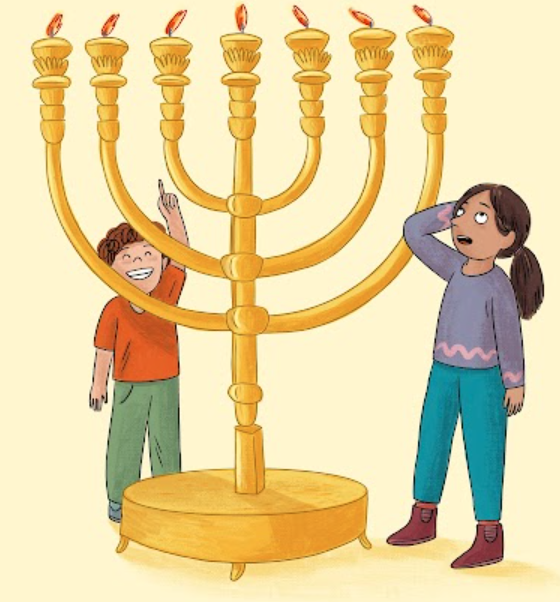
וְעָשִׂיתָ מְנֹרַת זָהָב טָהוֹר מִקְשָׁה תֵּעָשֶׂה הַמְּנוֹרָה
You shall make a menorah of pure gold; the menorah shall be made of a hammered piece of gold
שְׁלֹשָׁה קְנֵי מְנֹרָה מִצִּדָּהּ הָאֶחָד
Three branches on each side
שְׁלֹשָׁה גְבִעִים מְשֻׁקָּדִים בַּקָּנֶה הָאֶחָד כַּפְתֹּר וָפֶרַח
(33) On one branch there shall be three cups shaped like almond-blossoms, each with calyx and petals, and on the next branch there shall be three cups shaped like almond-blossoms, each with calyx and petals; so for all six branches issuing from the lampstand.
וְעָשִׂיתָ אֶת נֵרֹתֶיהָ שִׁבְעָה וְהֶעֱלָה אֶת נֵרֹתֶיהָ וְהֵאִיר עַל עֵבֶר פָּנֶיהָ
Make its seven lamps, and light its lamps so it gives off light in front of it.
How big?
The Torah doesn’t give dimensions for the menorah. According to the Gemara, it was 18 tefahim tall (Menahot 28b).
Curved or straight branches?
We don’t know for sure! Coins from the time of the Beit HaMikdash, and nearly every historical picture, show a menorah with curved branches (like it’s illustrated here). But a diagram in a manuscript of Rambam’s Mishnah commentary shows a menorah with straight branches. R. Avraham, son of the Rambam, writes that the branches were, “straight, as my father drew them, and not curved, as others have drawn” (commentary to Shemot 25:32).
Mizbehot מִזְבְּחוֹת
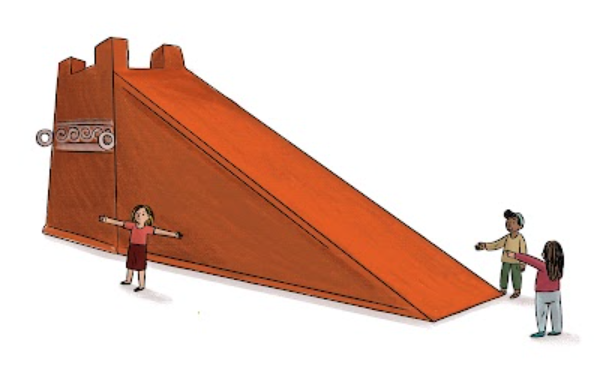
וְעָשִׂיתָ אֶת הַמִּזְבֵּחַ עֲצֵי שִׁטִּים
Make the mizbe’ah (altar) out of acacia wood
וְעָשִׂיתָ קַרְנֹתָיו עַל אַרְבַּע פִּנֹּתָיו… וְצִפִּיתָ אֹתוֹ נְחֹשֶׁת
Make its horns on the four corners… cover it all with copper
(ד) וְעָשִׂ֤יתָ לּוֹ֙ מִכְבָּ֔ר מַעֲשֵׂ֖ה רֶ֣שֶׁת נְחֹ֑שֶׁת
Make for it a lattice of mesh copper
וְנָתַתָּ֣ה אֹתָ֗הּ תַּ֛חַת כַּרְכֹּ֥ב הַמִּזְבֵּ֖חַ מִלְּמָ֑טָּה
Place it (the lattice) under the band
מִזְבַּח אֲדָמָה תַּעֲשֶׂה לִּי
Make for Me a mizbe’ah of earth
According to Rashi, this pasuk teaches that the mizbe'ah was filled with earth and also that it should be placed directly on the ground.
כֶּבֶשׁ (kevesh, ramp)
וְלֹא תַעֲלֶה בְמַעֲלֹת עַל מִזְבְּחִי
Don’t climb up stairs to My mizbe’ah
וְהָאֵשׁ עַל הַמִּזְבֵּחַ תּוּקַד בּוֹ לֹא תִכְבֶּה וּבִעֵר עָלֶיהָ הַכֹּהֵן עֵצִים בַּבֹּקֶר בַּבֹּקֶר וְעָרַךְ עָלֶיהָ הָעֹלָה וְהִקְטִיר עָלֶיהָ חֶלְבֵי הַשְּׁלָמִים׃
The fire on the mizbe’ah must be kept burning, it shouldn’t go out. Every morning the kohen must burn wood in it, lay out the olah sacrifice on it, and turn the fat parts of the shelamim sacrifices into smoke.
This mizbe’ah has a few different names!
- מִזְבַּח הַנְּחֹשֶׁת (mizbah ha-nehoshet, the copper altar)
- מִזְבַּח הַעֹלָה (mizbah ha-olah, the altar for the olah sacrifice)
- מִזְבַּח הַחִצוֹן (mizbah ha-hitzon, the outside altar)
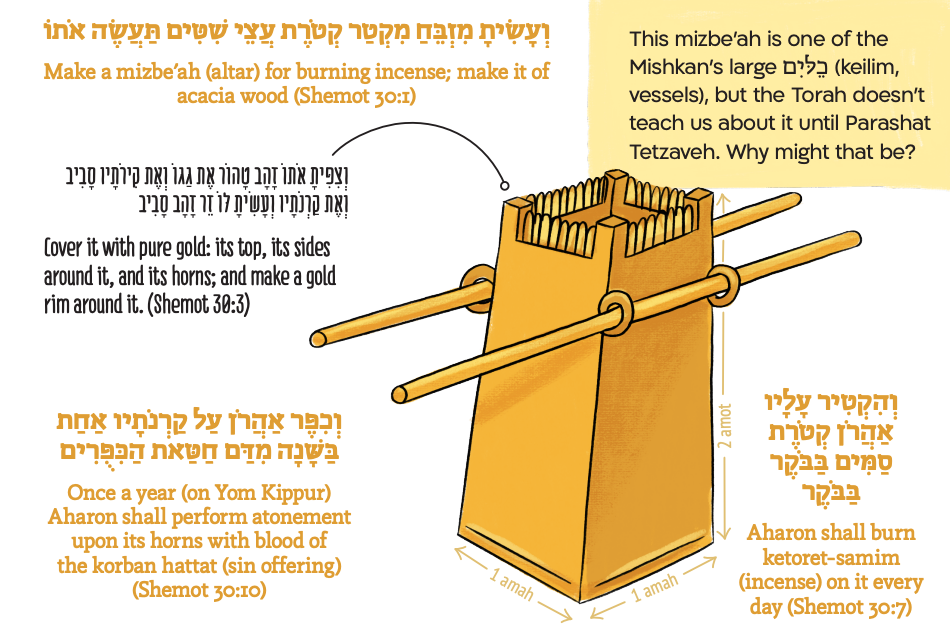
וְעָשִׂיתָ מִזְבֵּחַ מִקְטַר קְטֹרֶת עֲצֵי שִׁטִּים תַּעֲשֶׂה אֹתוֹ
Make a mizbe’ah (altar) for burning incense; make it of acacia wood
(ג) וְצִפִּיתָ֨ אֹת֜וֹ זָהָ֣ב טָה֗וֹר אֶת־גַּגּ֧וֹ וְאֶת־קִירֹתָ֛יו סָבִ֖יב וְאֶת־קַרְנֹתָ֑יו וְעָשִׂ֥יתָ לּ֛וֹ זֵ֥ר זָהָ֖ב סָבִֽיב׃
Cover it with pure gold: its top, its sides around it, and its horns; and make a gold rim around it.
וְהִקְטִ֥יר עָלָ֛יו אַהֲרֹ֖ן קְטֹ֣רֶת סַמִּ֑ים בַּבֹּ֣קֶר בַּבֹּ֗קֶר
Aharon shall burn ketoret-samim (incense) on it every day
וְכִפֶּר אַהֲרֹן עַל קַרְנֹתָיו אַחַת בַּשָּׁנָה מִדַּם חַטַּאת הַכִּפֻּרִים
Once a year (on Yom Kippur) Aharon shall perform atonement upon its horns with blood of the korban hattat (sin offering)
This mizbe’ah is one of the Mishkan's large כֵלּיִם (keilim, vessels), but the Torah doesn't teach us about it until Parashat Tetzaveh. Why might that be?
Midrash Ha-Gadol
The gold mizbe’ah is compared to a person’s soul, and the copper mizbe’ah to a person’s body….
The gold mizbe’ah was placed inside the Holy space (of the Mishkan), and the copper mizbeah was placed in the Mishkan’s courtyard.
The gold mizbe’ah was for offering the ketoret (incense), and the copper mizbe’ah was for offering animal meat.
Just like gold is more precious than copper, so too a person’s soul is more precious than their body.
And just like they would offer sacrifices to the Holy Blessed One every day on the copper mizbe’ah, so too must a person confess and examine their actions every single day before God always, serving God with soul and body.
מדרש הגדול
מִזְבַּח הַזָּהָב נִמְשָׁל בְּנַפְשׁוֹ שֶׁלָּאָדָם, וּמִזְבַּח הַנְּחֹשֶׁת בְּגוּפוֹ שֶׁלְּאָדָם….
מִזְבַּח הַזָּהָב הָיָה מֻנָּח בִּפְנִים שֶׁלְּקֹדֶשׁ וּמִזְבַּח הַנְּחֹשֶׁת הָיָה מֻנָּח בֶּחָצֵר שֶׁלְּקֹדֶשׁ.
מִזְבַּח הַזָּהָב הָיוּ מַקְטִירִין עָלָיו קְטֹרֶת סַמִּים וּמִזְבַּח הַנְּחֹשֶׁת הָיוּ מַקְרִיבִין עָלָיו בָּשָׂר שֶׁל בְּהֵמוֹת.
כְּשֵׁם שֶׁהַזָּהָב יָקָר מִן הַנְּחֹשֶׁת כָּךְ הַנֶּפֶשׁ יְקָרָה מִן הַגּוּף.
וּכְשֵׁם שֶׁהָיוּ מַקְרִיבִין בְּכָל יוֹם וָיוֹם קָרְבָּן לִפְנֵי הַקָּדוֹשׁ בָּרוּךְ הוּא עַל מִזְבַּח הַנְּחֹשֶׁת, כָּךְ צָרִיךְ אָדָם לְהִתְוַדּוֹת וּלְבַקֵּר מַעֲשָׂיו בְּכָל יוֹם וָיוֹם לִפְנֵי אֲדוֹן הָעוֹלָמִים תָּמִיד וְלַעֲבֹד אוֹתוֹ בְּנַפְשׁוֹ וְגוּפוֹ.
שֻׁלְחָן Shulhan
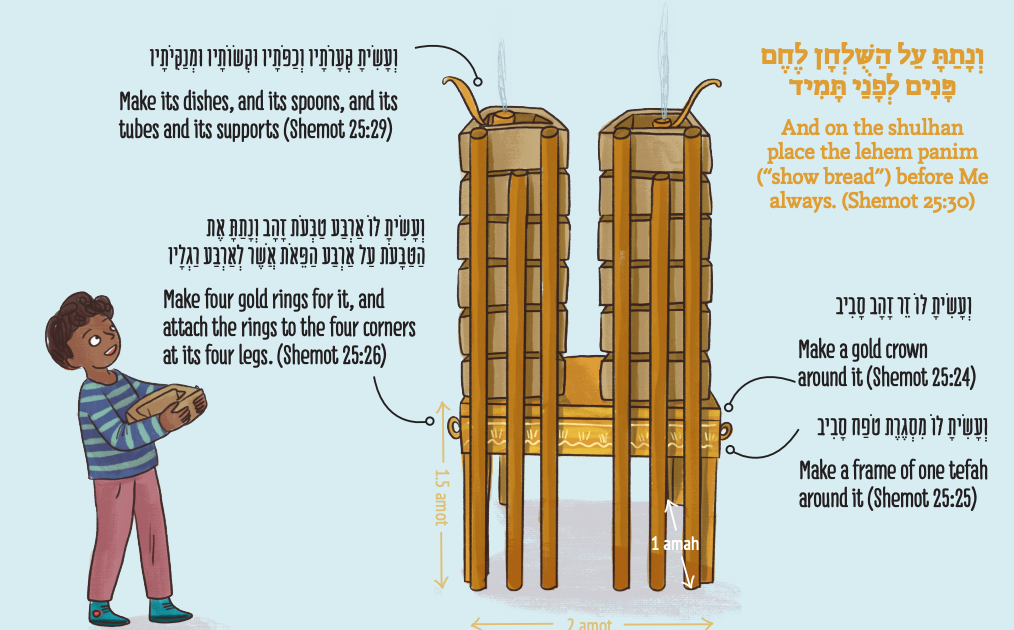
וְעָשִׂיתָ שֻׁלְחָן עֲצֵי שִׁטִּים…וְצִפִּיתָ אֹתוֹ זָהָב טָהוֹר
Make a shulhan (table) of acacia wood…cover it with pure gold
וְעָשִׂיתָ לּוֹ זֵר זָהָב סָבִיב
Make a gold crown around it
וְעָשִׂיתָ לּוֹ מִסְגֶּרֶת טֹפַח סָבִיב
Make a frame of one tefah around it
וְעָשִׂיתָ לּוֹ אַרְבַּע טַבְּעֹת זָהָב וְנָתַתָּ אֶת הַטַּבָּעֹת עַל אַרְבַּע הַפֵּאֹת אֲשֶׁר לְאַרְבַּע רַגְלָיו
Make four gold rings for it, and attach the rings to the four corners at its four legs.
וְעָשִׂיתָ קְּעָרֹתָיו וְכַפֹּתָיו וּקְשׂוֹתָיו וּמְנַקִּיֹּתָיו
Make its dishes, and its spoons, and its tubes and its supports
וְנָתַתָּ עַל הַשֻּׁלְחָן לֶחֶם פָּנִים לְפָנַי תָּמִיד
And on the shulhan place the lehem panim (“show bread”) before Me always.
Every Shabbat, 12 loaves of לֶחֶם הַפָּנִים (lehem ha-panim) were placed on the shulhan. The loaves from the previous week would be eaten by the כֹּהֲנִים (kohanim, priests).
אָמַר רַבִּי יְהוֹשֻׁעַ בֶּן לֵוִי נֵס גָּדוֹל נַעֲשָׂה בְּלֶחֶם הַפָּנִים—סִלּוּקוֹ כְּסִדּוּרוֹ.
R. Yehoshua ben Levi said: A great miracle happened with the lehem ha-panim—when it was removed, it was the same as when it was placed.
After sitting on the shulhan for an entire week, the loaves of lehem ha-panim were just as hot and fresh as when they were first placed on the shulhan!
- What could this miracle represent?
-------------------





